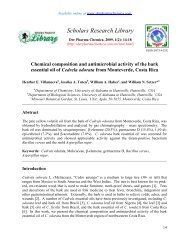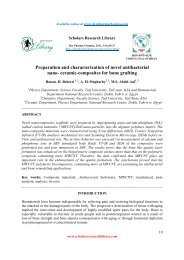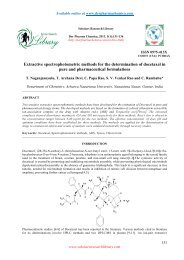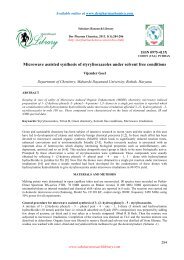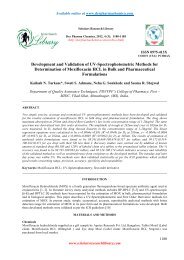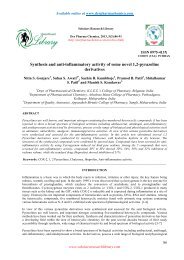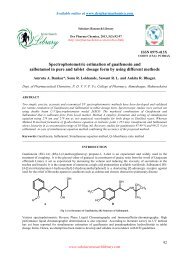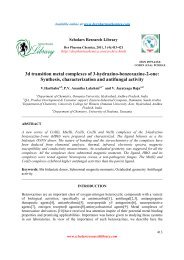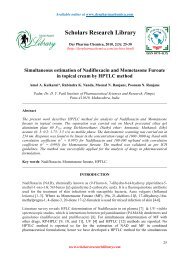Copper oxide nanoparticles-catalyzed direct N-alkylation of amines ...
Copper oxide nanoparticles-catalyzed direct N-alkylation of amines ...
Copper oxide nanoparticles-catalyzed direct N-alkylation of amines ...
Create successful ePaper yourself
Turn your PDF publications into a flip-book with our unique Google optimized e-Paper software.
Nagaraju Mittapelly et al Der Pharma Chemica, 2011: 3 (4):180-189_____________________________________________________________________________MATERIALS AND METHODSAll chemicals were purchased from Sigma-Aldrich and S.D Fine Chemicals, Pvt. Ltd. India andused as received. ACME silica gel (100–200 mesh) was used for column chromatography andthin-layer chromatography was performed on Merck-precoated silica gel 60-F 254 plates. All theother chemicals and solvents were obtained from commercial sources and purified using standardmethods. The IR spectra <strong>of</strong> all compounds were recorded on a Perkin-Elmer, Spectrum GX FTIRspectrometer. The IR values are reported in reciprocal centimeters (cm -1 ).The 1 H, 13 C NMR spectra were recorded on a Varian- 400 MHz, Bruker-Avance 300 MHzSpectrometer. Chemical shifts (δ) are reported in ppm, using TMS (δ =0) as an internal standardin CDCl 3 . ESI mass spectra were recorded on a Finnigan LCQ Advantagemax spectrometer. EImass spectra were recorded on a GC-MS QP2010 Plus (Shimadzu).Typical procedure for the N-<strong>alkylation</strong> <strong>of</strong> <strong>amines</strong> with alcohols: A mixture <strong>of</strong> amine (1mmol) alcohol (1.2 mmol), K 2 CO 3 (1.5 mmol) and CuO NPs (3 mol %) in toluene (3 mL) wasstirred at 110 o C temperature for 12 h. After completion <strong>of</strong> the reaction as indicated by TLC, thereaction mixture was centrifuged to separate the catalyst, the solid residue was washed withEtOAc to make the catalyst free <strong>of</strong> organic matter, and the reaction mixture was diluted withwater and then extracted with EtOAc. The combined organic layers were dried over anhydrousNa 2 SO 4 , concentrated in vacuo and purified by column chromatography on silica gel to affordthe pure product. All products were characterized by IR, 1 H NMR, 13 C NMR and massspectroscopic techniques.Spectroscopic data for the representative examples:1. Benzyl-phenyl-amine: (Table 2, entry 1): IR (neat): 3418, 2923, 1735, 1601, 1505,1252, 1069, 749 cm -1 . 1 H NMR (300 MHz, CDCl 3 ): δ 3.93 (brs, 1H), 4.31 (brs, 2H), 6.56 (d, 2H,J = 7.8 Hz), 6.65 (t, 1H, J = 7.2 Hz), 7.11 (d, 2H, J = 7.5 Hz), 7.21 – 7.35 (m, 5H). 13 C NMR (75MHz, CDCl 3 ): δ 48.26, 112.70, 117.5, 127.2, 127.4, 128.6, 129.2, 139.4, 148. ESI MS (m/z): 184(M + H).2. (4-Methoxy-benzyl)-phenyl-amine (Table 2, entry 2): Pale yellow oil; R f = 0.7 (inhexane/ethyl acetate 90:10). IR (neat): 749, 1032, 1175, 1244, 1507, 1604, 2835, 3415 cm -1 . 1 HNMR (300 MHz, CDCl 3 ): δ 3.78 (s, 3H), 3.83 (brs, 1H), 4.21 (s, 2H), 6.56 (d, 2H, J = 7.6 Hz),6.64 (t, 1H, J = 7.4 Hz), 6.81 (d, 2H, J = 8.5 Hz), 7.11 (m, 2H), 7.24 (d, 2H, J = 8.7 Hz). 13 CNMR (75 MHz, CDCl 3 ): δ 47.7, 55.2, 112.7, 113.9, 117.4, 128.7, 129.2, 131.3, 148.1, 158.8. ESIMS (m/z): 214 (M + H).3. (4-Methyl-benzyl)-phenyl-amine (Table 3, entry 3): IR (neat): 3418, 2920, 1603, 1507,1322, 1255, 1179, 749 cm -1 1 H NMR (300 MHz, CDCl 3 ): δ 2.34 (s, 3H), 3.86 (brs, 1H), 4.23 (s,2H), 6.54 (d, 2H, J = 7.6 Hz), 6.64 (t, 1H, J = 7.4 Hz), 7.06 – 7.14 (m, 4H), 7.20 (d, 2H, J = 7.9Hz). 13 C NMR (75 MHz, CDCl 3 ): δ 21.1, 48.1, 112.8, 117.5, 127.5, 129.2, 136.3, 136.8, 148.2.ESI MS (m/z): 198 (M + H).4. (4-Bromo-benzyl)-phenyl-amine (Table 2, entry 4): IR (neat): 3417, 1735, 1601, 1505,1231, 750 cm -1 1 H NMR (400 MHz, CDCl 3 ): δ 4.05 (brs, 1H), 4.29 (s, 2H), 6.60 (d, 2H, J = 8.7Hz), 6.72 (t, 1H, J = 7.3 Hz), 7.17 (m, 2H), 7.25 (d, 2H, J = 8.1 Hz), 7.46 (d, 2H, J = 8.1 Hz). 13 Cwww.scholarsresearchlibrary.com182
Nagaraju Mittapelly et al Der Pharma Chemica, 2011: 3 (4):180-189_____________________________________________________________________________NMR (75 MHz, CDCl 3 ): δ 47.8, 113.2, 118.1, 129.1, 129.3, 129.9, 138.2, 147.2. ESI MS(m/z): 262 (M + ), 264 (M + 2).5. 4-Phenylaminomethyl-phenol (Table 2, entry 5): IR (KBr): 3386, 1603, 1510, 1236cm -1 1 H NMR (300 MHz, CDCl 3 ): δ 4.21 (s, 2H), 4.50 (brs, 1H), 5.28 (s, 1H), 6.56 (d, 2H, J =7.6 Hz), 6.67 (t, 1H, J = 7.2 Hz), 6.73 (d, 2H, J = 8.6 Hz), 7.11 (2H, t, J = 7.3 Hz), 7.20 (d, 2H, J= 8.5 Hz). 13 C NMR (75 MHz, CDCl 3 ): δ 47.8, 113.1, 115.4, 117.7, 128.9, 129.2, 131.2, 148,154.7. ESI MS (m/z): 200 (M + H)6. Benzo[1,3]dioxol-5-ylmethyl-phenyl-amine (Table 2, entry 6): IR (KBr): 3410, 1602,1497, 1443, 1429, 1035, 746 cm -1 . 1 H NMR (300 MHz, CDCl 3 ): δ 3.96 9 (brs, 1H), 4.20 (s, 2H),5.91 (s, 2H), 6.61 (d, 2H, J = 7.7 Hz), 6.68 – 6.85 (m, 4H), 7.16 (t, 2H, J = 7.6 Hz). 13 C NMR(75 MHz, CDCl 3 ): δ 47.8, 100.7, 107.8, 108.1, 112.7, 117.4, 120.4, 129.1, 133.2, 146.5, 147.7,147.9. ESI MS (m/z): 228 (M + H).7. Phenyl-thiophen-2-ylmethyl-amine (Table 2, entry 7): Yellow oil; R f = 0.4 (inhexane/ethyl acetate 95:5). IR (KBr): 696, 750, 1258, 1315, 1504, 1601, 2923, 3409 cm -1 . 1 HNMR (300 MHz, CDCl 3 ): δ 3.38 (brs, 1H), 4.47 (s, 2H), 6.60 (d, 2H, J = 7.5 Hz), 6.68 (t, 1H, J =7.5 Hz), 6.91 (t, 1H, J = 3.0 Hz), 6.96 (s, 1H), 7.07-7.14 (m, 3H). 13 C NMR (75 MHz, CDCl 3 ): δ49.4, 113.1, 114.2, 118.1, 124.5, 125.0, 126.7, 129.2. EI MS (m/z): 189 (M + ).8. Cyclohexyl methyl-phenyl-amine (Table 2, entry 8): IR (KBr): 747, 1506, 1603, 3418,2923, 1603, 1506, 747 cm -1 . 1 H NMR (300 MHz, CDCl 3 ): δ 1.88-0.90 (m, 11H), 3.58 (brs, 1H),6.50 (d, 2H, J = 7.5Hz), 6.60 (t, 1H, J = 7.5Hz), δ 7.09 (m, 2H). 13 C NMR (75 MHz, CDCl 3 ): δ25.9, 26.5, 31.2, 37.5, 50.5, 112.5, 116.8, 129.1, 148.5. EI MS (m/z): 189 (M + ).9. Butyl-phenyl-amine (Table 2, entry 9): IR (neat): 3410, 2957, 1603, 1506, 1320, 747cm -1 1 H NMR (300 MHz, CDCl 3 ): δ 0.97 (t, 3H, J = 7.1 Hz), 1.38 – 1.50 (m, 2H), 1.56 - 1.65(m, 2H), 3.10 ( t, 2H, J = 6.9 Hz), 3.47 (brs, 1H), 6.52 (d, 2H, J = 7.7 Hz), 6.61 (t, 1H, J = 7.4Hz), 7.06 – 7.12 (m, 2H). 13 C NMR (75 MHz, CDCl 3 ): δ 13.8, 20.3, 31.6, 43.6, 112.6, 116.9,129.1, 148.5. ESI MS (m/z): 150 (M + H).10. Isobutyl-phenyl-amine (Table 3, entry 10): IR (neat): 3418, 2957, 1603, 1507, 1320,1259, 748 cm -1 . 1 H NMR (300 MHz, CDCl 3 ): δ 0.99 (d, 6H, J = 6.6 Hz), 1.82 – 1.96 (m, 1H),2.92 (d, 2H, J = 6.8 Hz), 3.66 (brs, 1H), 6.52 (d, 2H, J = 7.5 Hz), 6.61 (t, 1H, J = 7.2 Hz), 7.09 (t,2H, J = 7.5 Hz). 13 C NMR (75 MHz, CDCl 3 ): δ 20.5, 28.1, 51.8, 112.7, 117.1, 129.1, 148.5. ESIMS (m/z): 150 (M + H).11. N,N'-(1,4-phenylenebis(methylene))dianiline (Scheme 3): White solid; R f = 0.3(hexane/ethyl acetate 90:10). IR (KBr): 3448, 2919, 1603, 1507, 1324, 1174, 748 cm -1 . 1 H NMR(300 MHz, CDCl 3 ): δ 3.93 (s, 2H), 4.31 (s, 4H), 6.58 (d, 4H, J = 7.8 Hz), 6.68 (t, 2H, J = 7.8Hz), 7.11 – 7.14 (m, 4H), 7.33 (s, 4H). 13 C NMR (75 MHz, CDCl 3 ): δ 48.3, 112.9, 117.5, 127.6,129.4, 1383, 148.2. ESI MS (m/z): 289 (M+H).12. Benzyl-(4-chloro-phenyl)-amine (Table 3, entry 1): IR (KBr): 3412, 2831, 1618, 1506,1419, 1321, 1072, 791 cm -1 . 1 H NMR (300 MHz, CDCl 3 ): δ 3.95 (brs, 1H), 4.28 (s, 2H), 6.49 (d,2H, J =8.8 Hz), 7.06 (d, 2H, J = 8.8 Hz), 7.23 – 7.31 (m, 5H). 13 C NMR (75 MHz, CDCl 3 ): δ48.3, 113.9, 122.1, 127.4, 128.7, 129.1, 138.9, 146.7. ESI MS (m/z): 218 (M + H).www.scholarsresearchlibrary.com183
Nagaraju Mittapelly et al Der Pharma Chemica, 2011: 3 (4):180-189_____________________________________________________________________________13. Benzyl-(4-fluoro-phenyl)-amine (Table 3, entry 2): IR (neat): 3414, 2930, 1616,1512, 1457, 1236, 1033 cm -1 . 1 H NMR (300 MHz, CDCl 3 ): δ 3.84 (brs, 1H), 4.26 (s, 2H), 6.50(d, 2H, J = 8.8 Hz), 6.83 (d, 2H, J = 8.8 Hz), 7.22 – 7.32 (m, 5H). 13 C NMR (75 MHz, CDCl 3 ): δ48.8, 113.6, 115.4, 115.7, 127.4, 128.6, 139.2, 144.4, 157.3. ESI MS (m/z): 202 (M + H).14. Benzyl-p-tolyl-amine (Table 3, entry 3): IR (neat): 3419, 3019, 1609, 1512, 1473,1355, 749 cm -1 . 1 H NMR (300 MHz, CDCl 3 ): δ 2.22 (s, 3H), 3.80 (brs, 1H), 4.28 (s, 2H), 6.49(d, 2H, J = 8.5 Hz), 6.99 (d, 2H, J = 8.5 Hz), 7.21 – 7.35 (m, 5H). 13 C NMR (75 MHz, CDCl 3 ): δ20.3, 48.5, 112.9, 126.5, 127.0, 127.4, 128.5, 129.6, 139.5, 145.8. ESI MS (m/z): 198 (M +H).16. Benzyl-o-tolyl-amine (Table 3, entry 4): IR (neat): 3068, 3019, 2831, 1612, 1512, 1430,1279 cm -1 . 1 H NMR (300 MHz, CDCl 3 ): δ 2.19 (s, 3H), 3.81 (brs, 1H), 4.38 (s, 2H), 6.58 (d, 1H,J = 7.6 Hz), 6.63 (t, 1H, J = 7.6 Hz), 7.01 – 7.07 (m, 2H), 7.25 – 7.38 (m, 5H). 13 C NMR (75MHz, CDCl 3 ): δ 48.2, 109.9, 117.1, 121.8, 127.1, 127.5, 128.6, 130.0, 139.4, 146.0. ESI MS(m/z): 198 (M +H).17. Benzyl-(4-methoxy-phenyl)-amine (Table 3, entry 5): IR (KBr): 3375, 2944, 1629, 1511,1456,1236, 1033, 820 cm -1 . 1 H NMR (300 MHz, CDCl 3 ): δ 3.72 (s, 3H), 4.24 (s, 2H), 6.52 (d,2H, J = 9.0 Hz), 6.70 (d, 2H, J = 9.0 Hz), 7.21 – 7.35 9 (m, 5H). 13 C NMR (75 MHz, CDCl 3 ): δ48.9, 55.5, 113.8, 114.6, 126.9, 127.3, 128.4, 139.5, 142.2, 151.9. ESI MS (m/z): 214 (M + H).18. 4-Benzylamino-phenol (Table 3, entry 6): IR (KBr): 3381, 2920, 1614, 1507, 1239,1072cm -1 . 1 H NMR (300 MHz, CDCl 3 ): δ 3.88 (brs, 2H), 4.24 (s, 2H), 6.48 (d, 2H, J = 8.0 Hz), 6.62(d, 2H, J = 8.7 Hz), 7.20 – 7.33 (m, 5H). 13 C NMR (75 MHz, CDCl 3 ): δ 49.5, 114.8, 116.3,127.2, 127.7, 128.6, 139.4, 141.9, 148.2. ESI MS (m/z): 200 (M +H).19. N-benzyl-4-(benzyloxy) aniline (Table 3, entry 7): IR (KBr): 3392, 2922, 1723, 1511,1452, 1234, 1020, 820, 736, 694, 584 cm -1 . 1 H NMR (300 MHz, CDCl 3 ): δ 3.65 (brs, 1H), 4.25(s, 2H), 4.95 (s, 2H), 6.52 (d, 2H, J = 8.6 Hz), 6.76 (d, 2H, J = 8.8 Hz) 7.15-7.44 (m, 10H). 13 CNMR (75 MHz, CDCl 3 ): δ 49.4, 70.7, 113.9, 116.0, 127.1, 127.4, 127.7, 128.4, 128.5, 137.5,139.6, 142.6. ESI MS (m/z): 290 (M+H).20. 4-(Benzylamino)benzoic Acid (Table 4, Entry 4): 1 H NMR (300 MHz, CDCl3): δ 8.10 (d,J = 8.4 Hz, 2 H), 7.40–7.25 (m, 5H), 6.55 (d, J = 8.4 Hz, 2 H), 4.75 (br. s, 1 H), 4.40 (s, 2 H).13C NMR (75 MHz, CDCl3): δ = 170.3, 153.1, 138.2, 137.3, 130.2, 128.9, 127.2, 126.3, 117.4,111.2, 47.5 ppm. EI-MS (m/z): 228 [M + H] + .RESULTS AND DISCUSSIONIn our initial studies, an assortment <strong>of</strong> bases in combination with different solvents wereinvestigated using CuO NPs as the catalyst, benzyl alcohol and aniline as model substrates forthe synthesis <strong>of</strong> N-alkylated <strong>amines</strong> (Table 1). The conditions were optimized and the bestcondition was found to be 3 mol % <strong>of</strong> CuO NPs, 1.5 eq <strong>of</strong> K 2 CO 3 with toluene as the solvent andthe results are summarized in Table 1, entry 1. By virtue <strong>of</strong> these optimized conditions, thereaction afforded the desired product in 88 % yield. The reaction with CsCO 3 , Li 2 CO 3 , NaHCO 3and CH 3 COONa gave the product in moderate yield (Table 1, entries 3-6). However, thereaction with other bases such as Na 2 CO 3 , KO t Bu and NaO t Bu gave the desired product in goodyield (Table 1, entries 2, 7-8). Subsequently, the reaction conditions were optimized byemploying different solvents. Thus, various polar and non polar solvents were examined and itwww.scholarsresearchlibrary.com184
Nagaraju Mittapelly et al Der Pharma Chemica, 2011: 3 (4):180-189_____________________________________________________________________________was found that the product was obtained in moderate yield with 1, 4 dioxane and all othersolvents had negative influence on the reaction and no product was formed (Table 1, entry 9-10).Table 1. Solvent and base screening for the CuO NPs <strong>catalyzed</strong> N-<strong>alkylation</strong> <strong>of</strong> aniline with benzyl alcohol. aa Reaction conditions: aniline (1 mmol), benzyl alcohol (1.2 mmol), CuO NPs (3 mol %), solvent (3mL) and base (1.5equiv) at 110 o C for 12 h.Under the optimized reaction conditions, the scope <strong>of</strong> the reaction was explored with structurallyand electronically diverse alcohols with wide range <strong>of</strong> <strong>amines</strong>. The alcohols used for this studyincluded examples <strong>of</strong> benzylic, aliphatic and heterocyclic. As shown in the Table 2, irrespective<strong>of</strong> the electronic nature <strong>of</strong> the substituent, benzyl alcohols reacted smoothly to give thecorresponding products in good yields even with a benzyl alcohol bearing a substituent at orthoposition.(Table 2, entries 1-6). Whereas, heteroaromatic alcohol (thiophen-2-ylmethanol) gavethe corresponding product in moderate yield (Table 2, entry 7).Scheme 3On the other hand, aliphatic alcohols regardless <strong>of</strong> whether they are linear or branchedunderwent the reaction smoothly and gave the N-alkylated products in good yields (Table 2,entries 8-10).To show the convenience <strong>of</strong> our approach for the synthesis <strong>of</strong> multivalent structures, 1,4-phenylenedimethanol and aniline were reacted under the optimized reaction conditions to affordN,N'-(1,4-phenylenebis(methylene))dianiline in high yield, showing the versatility <strong>of</strong> thecatalytic system for generating multivalent structures (Scheme 3).In light <strong>of</strong> these excellent results, to evaluate the usefulness <strong>of</strong> the present N-<strong>alkylation</strong> system,various anilines were subjected to the N-<strong>alkylation</strong> with benzyl alcohol, in order to explore thewww.scholarsresearchlibrary.com185
Nagaraju Mittapelly et al Der Pharma Chemica, 2011: 3 (4):180-189_____________________________________________________________________________scope <strong>of</strong> amine substrates (Table 3). Chloro, fluoro, methoxy, methyl, hydroxy, acetylsubstituents were tolerant in the present reaction system.Table 2. Direct N-<strong>alkylation</strong> <strong>of</strong> aniline with different substituted benzyl alcohols and aliphatic alcohols. aa Reaction conditions as exemplified in typical experimental procedure.All <strong>of</strong> these reactions resulted in the selective formation <strong>of</strong> mono-alkylated aryl<strong>amines</strong> in good toexcellent yields. Even with o-toluidine bearing a substituent at ortho-position, the reactionproceeded in an excellent yield (Table 3, entry 4). In the reaction with 4-amino benzoic acidhaving electron- withdrawing substituent acetyl group, gave the product in moderate yield (Table3, entry 8).www.scholarsresearchlibrary.com186
Nagaraju Mittapelly et al Der Pharma Chemica, 2011: 3 (4):180-189_____________________________________________________________________________Table 3. Direct N-<strong>alkylation</strong> <strong>of</strong> different <strong>amines</strong> with benzyl alcohol. aa Reaction conditions as exemplified in typical experimental procedure.Table 4. Recovery and reuse <strong>of</strong> CuO NPs for the N-<strong>alkylation</strong> <strong>of</strong> aniline with benzyl alcohol aa Reaction conditions: aniline (5 mmol), benzyl alcohol (6 mmol), CuO NPs (3 mol %), K 2 CO 3 (1.5 equiv) andtoluene (10 mL) at 110 o C for 12 h.To check the recyclability <strong>of</strong> the catalyst, as can be seen from the Table 4, after the reaction <strong>of</strong>aniline with benzyl alcohol had reached completion, the catalyst was recovered from the reactionwww.scholarsresearchlibrary.com187
Nagaraju Mittapelly et al Der Pharma Chemica, 2011: 3 (4):180-189_____________________________________________________________________________mixture by centrifugation and reused up to four times without significant loss <strong>of</strong> catalyticactivity.CONCLUSIONIn conclusion, we have developed a CuO NPs <strong>catalyzed</strong> <strong>direct</strong> N-<strong>alkylation</strong> <strong>of</strong> <strong>amines</strong> withalcohols under ligand-free conditions. The present new catalytic system can provide anenvironmentally benign and versatile protocol for the synthesis diverse range <strong>of</strong> N-alkyl <strong>amines</strong>in good to excellent yields. The catalyst can be easily recovered and reused for several timeswithout any significant loss <strong>of</strong> activity.AcknowledgementNagaraju Mittapelly thanks the JNT University, Hyderabad for the financial support and researchfacilities.REFERENCES[1] For general references, see: (a) J. March, Advanced Organic Chemistry, 4th ed., Wiley, NewYork, 1992, p. 768, and references therein; (b) J. J. Brunet, D. Neibecker, F. Niedercorn, J. Mol.Catal. 1989, 49, 235; (c) J. P. Collman, L. S. Hegedus, J. R. Norton, R. G. Finke, Principles andApplications <strong>of</strong> Organotransition Metal Chemistry, University Sciences Books, Mill Valley,1987, chapters 7.4 and 17.1; (d) B. M. Trost, T. R. Verhoeven in Comprehensive OrganometallicChemistry (Eds.:G. Wilkinson, F. G. A. Stone, E. W. Abel), Pergamon, Oxford, 1982, Vol. 8, p.892, and references therein; (e) M. S. Gibson, in The Chemistry <strong>of</strong> the Amino Group (Ed.: S.Patai), Interscience, New York, 1968, p. 61.[2] (a) C. Kibayashi, Chem. Pharm. Bull. 2005, 53, 1375; (b) B. R. Brown, The OrganicChemistry <strong>of</strong> Aliphatic Nitrogen Compounds; Oxford University Press: New York, 1994; (c) A.Ricci, Modern Amination Methods; Wiley-VCH: Weinheim, Germany, 2000; (d) P. W. Roesky,T. E. Muller, Angew. Chem., Int. Ed. 2003, 42, 2708; (e) R. N. Salvatore, C. H. Yoon, K. W.Jung, Tetrahedron 2001, 57, 7785.[3] Hamid, M. H. S. A.; Slatford, P. A.; Williams, J. M. J. Adv. Synth. Catal. 2007, 349, 1555.[4] K. C. Hultzsch, D. V. Gribkov, Hampel, F. J. Organomet. Chem. 2005, 690, 4441; (b) J. F.Hartwig, Pure Appl. Chem. 2004, 76, 507; (c) S. Doye, Synlett 2004, 10, 1653; (d) J. Seayad, A.Tillack, C. G. Hartung, M. Beller, Adv. Synth. Catal. 2002, 344, 795; (e) M. Beller, C. Breindl,M. Eichberger, C. G. Hartung, J. Seayad, O. Thiel, A. Tillack, H. T. Rauthwein, Synlett 2002, 10,1579; (d) B. Sreedhar, P. S. Reddy, D. K. Devi, J. Org. Chem. 2009, 74, 8806.[5] (a) K. S. Mueller, F. Koc, S. Ricken, P. Eilbracht, Org. Biomol.Chem. 2006, 4, 826; (b) L.Routaboul, C. Buch, H. Klein, R. Jackstell, M. Beller, Tetrahedron Lett. 2005, 46, 7401; (c) A.Moballigh, A. Seayad, R. Jackstell, M. Beller, J. Am. Chem. Soc. 2003, 125, 10311; (d) P.Eilbracht, L. Barfacker, C. Buss, C. Hollmann, B. E. K. Rzychon, C. L. Kranemann, T. Rische,R. A. Schmidt, Chem. Rev. 1999, 99, 3329.[6] (a) R. Grigg, T. R. B. Mitchell, S. Sutthivaiyakit, N. Tongpenyai, J. Chem. Soc., Chem.Commun. 1981, 611; (b) Y. Watanabe, Y. Tsuji, Y. Ohsugi, Tetrahedron Lett. 1981, 22, 2667;(c) A. D. Zotto, W. Baratta, M. Sandri, G. Verardo, P. Rigo, Eur. J. Inorg. Chem. 2004, 524; (d)Y. Watanabe, Y. Morisaki, T. Kondo, T. Mitsudo, J. Org. Chem.1996, 61, 4214; (e) T. Kondo, S.Yang, K. T. Huh, M. Kobayashi, S. Kotachi, Y. Watanabe, Chem. Lett. 1991, 1275; (f) S.Ganguly, D. M. Roundhill, Polyhedron 1990, 9, 2517; (g) Ganguly, S.; Joslin, F. L.; Roundhill,D. M. Inorg. Chem. 1989, 28, 4562; (h) G. Bitsi, E. Schleiffer, F. Antoni, G. Jenner, J.Organomet.Chem. 1989, 373, 343; (i) G. Jenner, G. Bitsi, J. Mol. Catal. 1988, 45, 165; (j) K. T.www.scholarsresearchlibrary.com188
Nagaraju Mittapelly et al Der Pharma Chemica, 2011: 3 (4):180-189_____________________________________________________________________________Huh, Y. Tsuji, M. Kobayashi, F. Okuda, Y. Watanabe, Chem. Lett. 1988, 449; (k) Y. Tsuji, K.T. Huh, Y. Watanabe, J. Org. Chem. 1987, 52, 1673; (l) J. A. Marsella, J. Org. Chem. 1987, 52,467; (m) Y. Watanabe, Y. Tsuji, H. Ige, Y. Ohsugi, T. Ohta, J. Org. Chem. 1984, 49, 3359; (n)S. I. Murahashi, K. Kondo, T. Hakata, Tetrahedron Lett. 1982, 23, 229; (o) A. Arcelli, B. T.Khai, G. Porzi, J. Organomet. Chem. 1982, 235, 93; (p). B.T. Khai, C. Concilio, G. Porzi, J.Org. Chem. 1981, 46, 1759; (q) A. Tillack, D. Hollmann, D. Michalik, M. Beller, TetrahedronLett. 2006, 47, 8881; (r) A. Tillack, D. Hollmann, D. Michalik, M. Beller, Chem. Asian. J. 2007,2, 403.[7] N. Tanaka, M. Hatanka, Y. Watanabe, Chem. Lett. 1992, 575.[8] Y. Tsuji, R. Takeuchi, H. Ogawa, Y. Watanabe, Chem. Lett. 1986, 293.[9] (a) G. Cami-Kobeci, P. A. Slatford, M. K. Whittlesey, J. M. Williams, Bioorg. Med. Chem.Lett. 2005, 15, 535; (b) K. Fujita, Y. Enoki, R. Yamaghuchi, Tetrahedron 2008, 64, 1943.[10] P. R. Likhar, R. Arundhathi, M. L. Kantam, P. S. Prathima, Eur. J. Org. Chem. 2009, 5383.[11] S. Wang, Z. Wang, Z. Zha, Dalton Trans., 2009, 9363.[12] (a) L. Rout, T. K. Sen, T. Punniyamurthy, Angew. Chem., Int. Ed. 2007, 46, 5583; (b) M. L.Kantam, S. Laha, J. Yadav, B. M. Choudary, B. Sreedhar, Adv. Synth. Catal. 2006, 348, 867. (c)J. Zhang, Z. Zhang, Y. Wang, X. Zheng, Z. Wang, Eur. J. Org. Chem. 2008, 511. (d) J. Beckers,G. Rothenberg, Dalton Trans. 2008, 6573. (e) M. B. Thathagar, J. Beckers, G. Rothenberg, Adv.Synth. Catal. 2003, 345, 979; (f) V. P. Reddy, A. V. Kumar, K. Swapna, K. R. Rao, Org. Lett.,2009, 11, 951; (g) M. Kidwai, S. R. Bhardwaj Poddar, Beilstein J. Org. Chem. 2010, 6, 35.[13] CuO nano particles (mean particle size, 33 nm, surface area, 29 m 2 /g and purity, 99.99%)were purchased from Sigma Aldrich.www.scholarsresearchlibrary.com189



